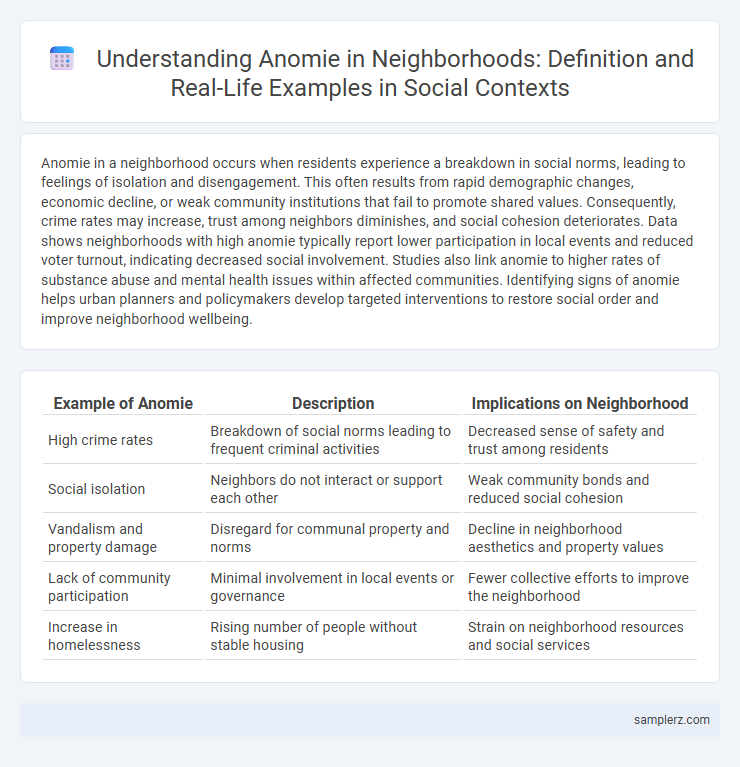Anomie in a neighborhood occurs when residents experience a breakdown in social norms, leading to feelings of isolation and disengagement. This often results from rapid demographic changes, economic decline, or weak community institutions that fail to promote shared values. Consequently, crime rates may increase, trust among neighbors diminishes, and social cohesion deteriorates. Data shows neighborhoods with high anomie typically report lower participation in local events and reduced voter turnout, indicating decreased social involvement. Studies also link anomie to higher rates of substance abuse and mental health issues within affected communities. Identifying signs of anomie helps urban planners and policymakers develop targeted interventions to restore social order and improve neighborhood wellbeing.
Table of Comparison
| Example of Anomie | Description | Implications on Neighborhood |
|---|---|---|
| High crime rates | Breakdown of social norms leading to frequent criminal activities | Decreased sense of safety and trust among residents |
| Social isolation | Neighbors do not interact or support each other | Weak community bonds and reduced social cohesion |
| Vandalism and property damage | Disregard for communal property and norms | Decline in neighborhood aesthetics and property values |
| Lack of community participation | Minimal involvement in local events or governance | Fewer collective efforts to improve the neighborhood |
| Increase in homelessness | Rising number of people without stable housing | Strain on neighborhood resources and social services |
Rising Crime Rates: A Sign of Neighborhood Anomie
Rising crime rates in neighborhoods often indicate anomie, reflecting weakened social bonds and a breakdown of shared values among residents. Areas with increased vandalism, theft, and violence experience diminished community trust, fostering an environment where social norms are disregarded. This erosion of collective efficacy undermines neighborhood stability and exacerbates feelings of alienation and insecurity.
Breakdown of Community Trust and Social Bonds
Neighborhoods experiencing anomie often face a breakdown of community trust and social bonds, manifesting in increased isolation among residents and diminished collective efficacy. This erosion leads to less cooperation in maintaining public safety and caring for communal spaces, resulting in higher crime rates and neglect of neighborhood infrastructure. Studies show that weakened social networks correlate strongly with feelings of alienation and decreased community participation.
Vandalism and Public Property Neglect as Anomie Indicators
Vandalism and public property neglect serve as clear indicators of anomie within neighborhoods, reflecting a breakdown of social norms and community cohesion. These behaviors signal residents' disconnection from shared values, resulting in increased crime rates and decreased trust among neighbors. Addressing these issues through community engagement and social regulation can help restore order and strengthen neighborhood bonds.
Youth Disengagement and Gang Formation
High levels of youth disengagement in neighborhoods often lead to anomie, where weakened social norms create a void filled by gang formation. The absence of community support and economic opportunities fosters alienation among young people, pushing them toward gangs for identity and protection. This cycle exacerbates crime rates and undermines neighborhood cohesion, perpetuating social instability.
Isolation and Lack of Collective Activities
In neighborhoods experiencing anomie, residents often face social isolation and a noticeable lack of collective activities such as community events or neighborhood watches. This absence of social cohesion weakens communal bonds, leading to decreased trust and engagement among neighbors. The resulting fragmentation creates an environment where feelings of alienation and neglect dominate, undermining the social fabric of the community.
Disintegration of Family Structures in Local Areas
The disintegration of family structures in local neighborhoods often leads to social anomie, characterized by weakened social bonds and diminished community cohesion. High rates of single-parent households and fragmented family units contribute to decreased social regulation and increased feelings of isolation among residents. These conditions undermine neighborhood stability and escalate issues such as crime and youth delinquency.
Economic Instability Influencing Social Norms
Economic instability in neighborhoods often leads to weakened social norms as residents prioritize survival over community engagement, resulting in increased crime and diminished trust. Job scarcity and financial stress disrupt traditional social structures, causing a breakdown in shared values and collective responsibility. This anomie fosters social isolation and undermines efforts to maintain neighborhood cohesion.
Increased Substance Abuse in the Community
In neighborhoods experiencing social disintegration, increased substance abuse often emerges as a clear example of anomie, reflecting weakened social norms and community bonds. Residents may turn to drugs and alcohol as coping mechanisms in the absence of collective oversight and mutual support. This rise in substance misuse contributes to further decline in neighborhood cohesion and overall public safety.
Erosion of Shared Values and Cultural Practices
Anomie in neighborhoods manifests through the erosion of shared values and cultural practices, leading to weakened social cohesion and a decline in community engagement. This breakdown often results in increased feelings of isolation, mistrust among residents, and the neglect of communal responsibilities. Such environments struggle to maintain social order, making it challenging to foster collective identity and mutual support.
Neighbor Alienation and Declining Social Participation
Neighbor alienation in neighborhoods often leads to anomie, as residents experience weakened social bonds and diminished trust. Declining social participation, such as reduced involvement in community events or local organizations, exacerbates feelings of isolation and social fragmentation. This erosion of collective efficacy undermines neighborhood cohesion and heightens vulnerability to social problems.

example of anomie in neighborhood Infographic
 samplerz.com
samplerz.com